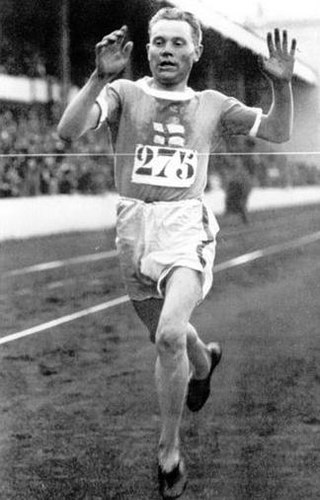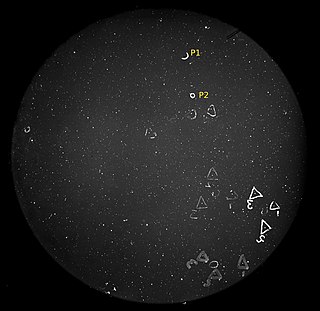
Paavo Johannes Nurmi was a Finnish middle-distance and long-distance runner. He was called the "Flying Finn" or the "Phantom Finn" because he dominated distance running in the 1920s. Nurmi set 22 official world records at distances between 1,500 metres and 20 kilometres, and won nine gold and three silver medals in his 12 events in the Summer Olympic Games. At his peak, Nurmi was undefeated for 121 races at distances from 800 m upwards. Throughout his 14-year career, he remained unbeaten in cross country events and the 10,000 metres.

Turun Palloseura, commonly known as TPS, is a professional football club based in Turku, Finland. During the 2024 season, the men's first team of the club competes in new Ykkösliiga, the second highest tier of men's football, and the women's representative team in the Kansallinen Liiga, the highest level of women's football in Finland. Nicknamed "Tepsi", the club was founded in 1922.

Wäinö Valdemar Aaltonen was a Finnish artist and sculptor. The Chambers Biographical Dictionary describes him as "one of the leading Finnish sculptors".

Ruissalo is an island in the Archipelago Sea and a district of the city of Turku, Finland. The island is located to the south-west of the city, between Hirvensalo and Pansio in the mainland. It is rather sparsely populated, having a population of only 126, with an annual growth rate of 3.97%. The villas on the island are considered culturally and historically valuable in Finland. Some are used as guesthouses; some are owned and run by foundations, labor unions, sports teams, and private enterprises in the area; some can be rented freely for days for private parties such as weddings; some have cafeterias in them. Private ownership exists – a couple villas even have renters with very selective occupancy. Some villas have deteriorated because of the high maintenance costs due to the historical building methods that must be used here.

The III District is one of the central districts of Turku, Finland. It is located on the east side of the river Aura, between Kaskenkatu and Martinkatu. The district is largely composed of the Samppalinna sports park, and includes sporting venues such as the Paavo Nurmi Stadion as well as cultural sites such as the city theatre and the Wäinö Aaltonen Museum of Art.
Eino Ilmari Oksanen was a Finnish marathon runner who won the Boston Marathon three times. Oksanen also won the 1957 Turku Marathon in Finland and the 1959 Athens Peace Marathon.

The Garmin Helsinki City Marathon is an annual marathon held in Helsinki, Finland. It was established in 1981 and it used to be held in August but has now moved to May, on the day called Helsinki City Running Day.
The Paavo Nurmi Marathon is an annual road running event held each August in Iron County, Wisconsin, in the United States. The course begins in the town of Upson and continues along Highway 77 through the communities of Iron Belt, Pence and Montreal. Near Carey, the race turns down County Highway C, clips past the Gile Flowage and proceeds along U.S. Route 51 into the city of Hurley. The finish line is located on Silver Street in Hurley, where the race finishers are served a traditional Finnish stew called Mojakka.

Finland competed at the 1920 Summer Olympics in Antwerp, Belgium for the first time as a fully independent state. It did compete at the previous Olympics, however, only as the Russian-dependent Grand Duchy of Finland. 63 competitors, 62 men and 1 woman, took part in 51 events in 9 sports.
Turun Urheiluliitto (TuUL) is a sports club from Turku, Finland that was founded in 1901. The club includes sports teams for cross-country skiing, bowling, volleyball, ice skating, boxing, cycling, triathlon, gymnastics, and track and field.

Elias Katz was a Finnish track and field athlete, who competed mainly in the 3000 metres steeplechase.

Paavo Nurmi Stadium is a multi-use stadium in Turku, Finland. It is currently used mostly for football matches and athletics meets. It holds 13,000 people and is named after the Turku-born runner Paavo Nurmi. Twenty athletics world records have been set at the stadium. John Landy broke the world records for the 1,500 m and the mile (1954), Nurmi for the 3,000 m (1922), Emil Zátopek (1950) and Ron Clarke (1965) for the 10,000 m, Viljo Heino for the one-hour run (1945) and the 20 km (1949), Matti Järvinen for the javelin throw (1932) and Charles Hoff for the pole vault (1925).

1740 Paavo Nurmi, provisional designation 1939 UA, is rare-type asteroid from the inner regions of the asteroid belt, approximately 13 kilometers in diameter.
Cephas Matafi is a Zimbabwean long-distance runner. He competed for his native country at the 1992 Summer Olympics in Barcelona, Spain, where he finished in 58th place (2:26:17) in the men's marathon race. His personal best time is 2:15:14 hours, achieved in 1992. He is a two-time champion of the Paavo Nurmi Marathon (Turku) in Finland.

The men's marathon at the 1932 Summer Olympics took place on August 7. It started and finished at the Los Angeles Memorial Coliseum. Twenty-eight athletes from 14 nations competed. The 1930 Olympic Congress in Berlin had reduced the limit from 6 athletes per NOC to 3 athletes. The event was won by Juan Carlos Zabala of Argentina, the nation's first Olympic marathon medal. Great Britain also earned its first Olympic marathon medal with Sam Ferris's silver, while Finland made the marathon podium for a fourth consecutive Games as Armas Toivonen won bronze.
Paavo the Great. Great Race. Great Dream. is an opera in three acts by Finnish composer Tuomas Kantelinen to a libretto by the poet Paavo Haavikko. The opera deals with the life of the Finnish middle- and long-distance runner Paavo Nurmi who won a total of nine Olympic gold medals in the 1920s. It was premiered in the Helsinki Olympic Stadium in 2000 as Helsinki was one of the European Capitals of Culture. The title refers to Nurmi's great ambition to win the marathon race at the 1940 Helsinki Olympics, which were not held because of the outbreak of World War II.

The Paavo Nurmi Games is an annual track and field meet that takes place at Paavo Nurmi Stadium in Turku, Finland. It was first held in 1957. The competition has been part of the IAAF World Challenge since 2017.

Linda Maria Sandblom is a Finnish high jumper, who represents HIK Friidrott Hanko. Until 2013 she represented Hangö IK. She is coached by Matti Nieminen and Leif Sandblom.

The 2020 Finnish Athletics Championships was the year's national outdoor track and field championships for Finland. It was held on 13–16 August at the Paavo Nurmi Stadium in Turku.

The Paavo nurmi statue is a whole-body sculpture of runner Paavo Nurmi, the most successful Olympic athlete in Finland, made by sculptor Wäinö Aaltonen. The bronze sculpture was made in 1925 and there have been four additional casts of it. The statue has become a symbol for Finnish sport and the independent Finnish nation as well as an envoy of the image of Finland.













